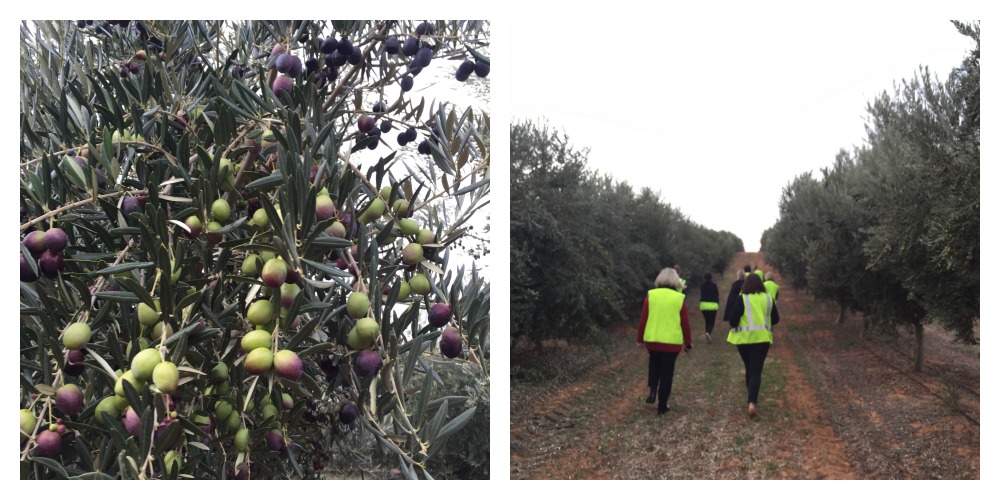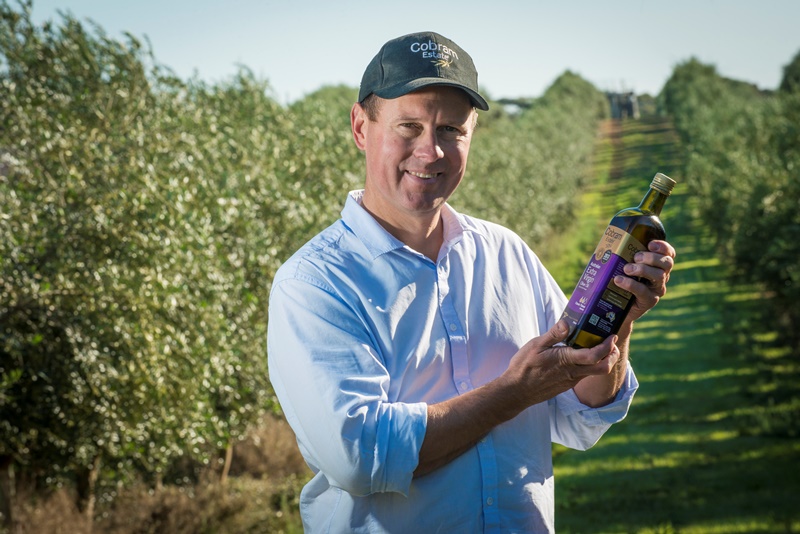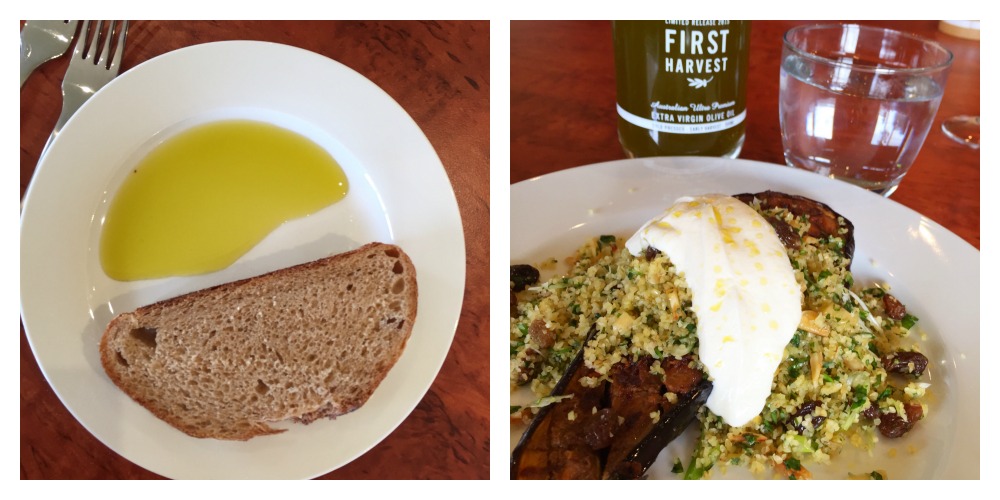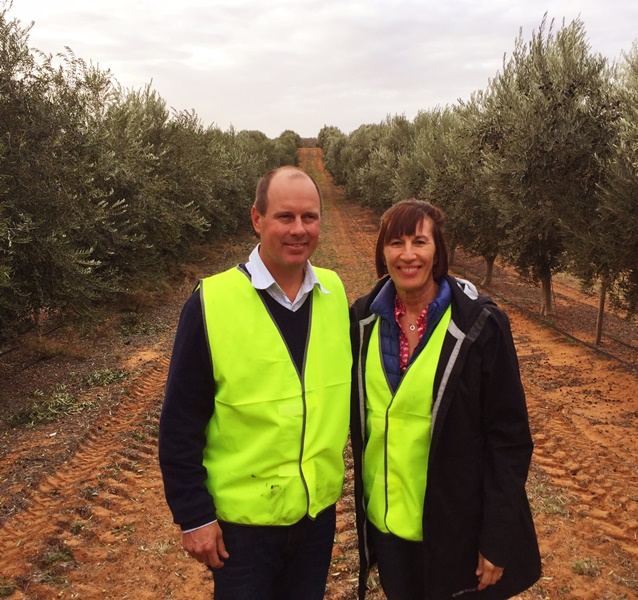My visit to see the Cobram Estate olive harvest

I’m a great fan of extra virgin olive oil so was delighted to have the chance to fly to the Boundary Bend olive grove in Mildura in Northern Victoria to see the olive harvest in full swing. With its cold winters and long hot growing season, this is an ideal dry Mediterranean-esque climate, and you can see how well their trees thrive along the banks of the Murray River. I had plenty of opportunity to ask questions about oil types and update my knowledge, so wanted to share this experience with you.
Harvesting of the olives
We drove past rows and rows of olive trees, all growing neatly in parallel rows about five metres apart. The trees weren’t that tall – the trunks were no more than 20 cm in height – but their branches were heavy with clusters of fruit, varying in colour from green at the base, through to purple/black near the top, and all graduations in between. Walking down a row, I couldn’t help but notice how so many trees were laden with fruit. Interestingly, some trees had lots, while others only a scant offering.
We climbed onto a huge custom-made harvesting machine that straddled the top of the trees and travelled slowly down the rows. Once on board, it was amazing to watch the olive fruit being shaken and stripped off the branches, onto a myriad of narrow conveyor belts, then bounce merrily along into the large bucket of a companion tractor that was slowly moving alongside the harvester.

Once full, the truck then made its way back to the processing plant to deposit its bounty of freshly harvested olives. This process then repeats and repeats, until the olives from than one million olive trees on the 3,500 hectare grove (yes, a million!) are harvested.
There is a second grove with another million trees making their total tree population around 2.2 million which is pretty awesome. Impressively, Cobram aim to extract the oil within hours of the fruit being picked, so as to maintain the freshness and best flavour.
As we walked along between the rows of trees, I was surprised at how sandy the soil was; it was not dissimilar to walking and sliding on a beach, except that this soil was deeper orange in colour. I wondered how anything would grow in such sandy soil, let alone all these olive trees. But clearly, they can and do flourish!
This Mildura-based grove has its own nursery and is continually experimenting with different varieties of olive trees to grow in the region. You could see sawn-off stumps of former olive trees that had been tried but were deemed unsuccessful. I was told this was due to many reasons – sometimes it was the fruit that proved too hard to harvest, sometimes the yield was too low, or sometimes the tree took too long to grow to a commercial height.

In between the old stumps, I could see new baby trees that had been planted just one or two years ago, that are still too young to bear fruit.
Pressing the olives
Rob McGavin is the co-Founder and Executive Chairman of Boundary Bend (pictured above), Australia’s largest olive company and one that specialises in the production of extra virgin olive oil (EVOO) under the Cobram brand. Rob took us (the group was made up of six editors and health journalists) through the whole process of squeezing the oil from the freshly harvested olives.
We started at the point where the trucks drop their load of fresh olives into huge underground vats, which then get taken into the crushing area via conveyor lines. Everything was scrupulously clean, so I could see their strict hygiene procedures were in place at every step. A fully computerised traceability system on the grove, allows them to monitor all oils to ensure the highest quality control and to allow trackbacks if there’s a problem.
Once inside, all that can be seen is a series of large stainless steel boxes and bins, and lots of machinery; and it’s noisy in there! When Rob opened a hatch we could see the olives being cleaned so they were free from any leaf matter, after which they then headed up to the crusher via the continuous extraction system.
Here, the olives were turned into a paste (called a ‘tapenade’), which is a thickish grey/brown mass made up of crushed olive flesh, water and olive stones. Think sludge! Then the magic happened. We stood in awe and watched a stream of liquid gold poor out of the tapenade and into a holding pen.

The crude oil was allowed to settle before it was then piped into holding tanks. Meanwhile, the foamy scum on the top was removed. From here the lovely oil will be transported to Geelong to their bottling facility, where it will be bottled and dispatched as orders.
The whole process runs 24 hours during the harvesting season, which is typically from April to early June. It was all quite impressive in terms of its size and cleanliness, and everything is designed to ensure the olives are processed on site and within hours, in order to capture their optimum aroma and flavours.
Taste testing with Leandro
To appreciate the differences between the various olive oils, we were taken through a guided taste testing of five Cobram Estate oils. It was a wonderful experience to be able to smell and taste them, as we had help from Leandro Ravetti, Cobram’s Head Olive Oil Maker and Agricultural Engineer.
I loved that Leandro told us what to expect as we taste tested each oil. For example, with his help, I picked out the ‘fresh notes,’ which he labelled as ‘fresh cut grass’ or ‘green tomato’. Or ‘floral notes,’ such as ‘tropical fruits’ or ‘apple’. I found this process fascinating, as I’ve never been able to identify flavours like that. Some of us even had a ticklish cough in the throat, from the pepperiness of a couple of the oils. You could hear muffled coughing here and there!
Obviously the oil notes change once the oils are paired with food, but it proved to be an interesting exercise to do side-by-side, as it highlighted how different oils suit different cooking purposes. For example, a lighter, milder oil teams better with fish or risotto, while a hotter oil or one with more bite pairs well with ripe tomatoes and basil.
Nutrition and olive oil
Rob talked us through the health issues associated with EVOO. We discussed the content of polyphenols and beta-carotene (antioxidants) and its squalene (a natural fat-like component). He highlighted the lack of trans fat in EVOO (as there’s no heating) and the fact that labs can now test for over-refining and over-heating in other oils by measuring such things called stigmastadienes in a lab.
EVOO offers many health benefits, including protection from heart disease and inflammation, reduction of blood pressure, and weight loss. There is also research showing EVOO has anti-ageing benefits, due to its ability to lower oxidation. Simple strategies such as eating vegetables or salad with EVOO are all that's needed to initiate these changes.
We spent a lot of time discussing that one can even cook with EVOO at high temperatures. I used to believe that it should only be used cold over cooked vegetables or in a salad dressing (for example). However, a high quality EVOO such as Cobram Estate’s has a very low level of free fatty acid and, therefore, the smoke point is between 205ºC and 215ºC, which is substantially higher than the ideal temperature for frying food (which is 180ºC.)
Most imported EVOOs in Australia are lower quality and therefore, consistently have high levels of free fatty acid; and this is why you can’t successfully cook with them. However, with the Cobram brand, you can pan-fry or sauté in EVOO, which means you only need one oil in your kitchen!
Olive oil for lunch
Lunch enabled us to experience the taste of fresh-made EVOO. Naturally, it started with a simple plate of their oil alongside a chunk of bread for dipping. Yummo! We were then served fresh buffalo mozzarella that was topped with a gutsy pesto – made using their olive oil, of course.
The main course was half a roasted eggplant, with a salad of couscous, pistachios, lentils, fresh herbs and spring onions. Even the dessert made with olive oil! It was an orange olive cake served with thick yoghurt – delicious.

All in all, our visit was a most interesting experience and I feel privileged to see first-hand how EVOO is produced here in Australia. I shall certainly be supporting these Australian oils and Australian farmers, by buying a fresh local oil rather than a poorer quality import.
What I learned about extra virgin olive oil (EVOO)
EVOO:
- has a great nutrition profile (which I already knew, but it was great to have it confirmed), being high in monounsaturated fats, polyphenols and squalene.
- is minimally processed, so is closest to the original olives (it is, literally, the juice ‘squeezed’ out of the olive flesh!).
- makes veges and salad tastes so good that you’ll eat more! Allow 1 tablespoon to dress 1 cup of vegetables.
- can be used for cooking, which was something I had always thought was a no-no. This relies on the quality of the oil, which in turn is influenced by the acidity or level of free (unbound) fatty acid.
- does not improve over time – it is not like wine. Instead, EVOO is best consumed fresh and definitely within six months of harvest. The key message here is don’t hang on to that special bottle waiting for a special occasion – have it now! The beneficial nutrients and fresh flavours will decrease as the oil ages.
- Australian EVOO travels less food miles than imported oils to reach you. This means buying Australian will deliver you a fresher oil and sooner, which equates to more nutrition and flavour; as well as a better return for our famers.
Many imported oils have been found to be rancid, stale or, in some cases, cut with seed oils or even base-grade lampante or lamp oil, which is deemed unfit for human consumption.
Buy oil in dark glass bottles and store it in a dark cupboard away from light and heat, as these elements will cause the quality to deteriorate.
Facts about Cobram Estate’s olive oil
- Cobram Estate is part of an impressive operation near Mildura (VIC), with 2.2 million trees planted, representing 14 olive varieties of Italian, Spanish and Israeli origin, including the five major ones of Arbequina, Barnea, Coratina, Picual and Frantoio.
- Cobram supply around 60 per cent of Australia’s olive oil, which makes them a major player and a leading brand in supermarkets.
- Cobram Estate Extra Virgin Olive Oils have won over 150 awards, including a massive medal haul of seven awards in this year’s prestigious New York International Extra Virgin Olive Oil Competition.
- Their EVOO is certified to Australian standards and carries the triangle certification symbol (read more here).




